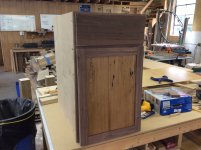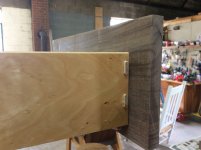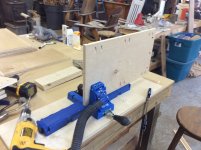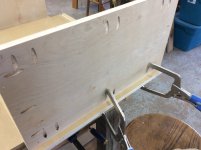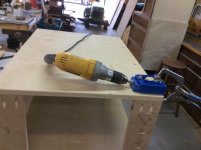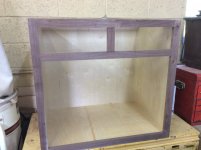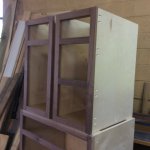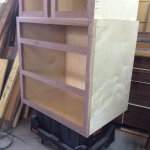That's a beautiful combination of woods!
A couple of thoughts:
1) You have some checking at the end of your drawer face. It's hard to tell how serious it is from the photos, but it looks like it is worse than I would probably allow if it were mine. It is likely to get worse over time, and it could eventually become a visible split in the front of the drawer face. To prevent this, my usual practice when milling is to start by cutting the last couple inches off the end of the board until there is no meaningful checking in the end grain, and then mill the board to size. If you're going to use this board for your drawer face with the checking in place, you might consider mixing some epoxy with walnut dust and pressing it in the end checks to keep it from getting worse.
2) Proportions are always tricky, especially in something like kitchen cabinets that have to sized according to function. However, looking just at this cabinet, the drawer face seems bulky compared to the thin rails and stiles on your door frame. To some extent, that may be inevitable, because you're going to have drawer faces of varying sizes, and your rails and stiles need to be fairly uniform throughout the kitchen. But if you're going to have a lot of drawer faces that are this size or bigger, you might consider slightly wider rails and stiles so that they don't look spindly next to the more massive drawer faces. Wider rails and stiles would also decrease the amount of visual real estate that the panels consume. This could be a good thing. While I really like the visual interest that your wormy chestnut offers, I suspect that by the time you have a whole kitchen full of it, all of that detail will become intense. That intensity will be there no matter how big or small your panels are, but reducing the panel size slightly by adding an extra 1/4" - 1/2" width on your door frames would soften it a bit.
3) You might experiment with softening the edges of the door frame and drawer face. My view is that overlay doors and drawers look very harsh when the edges are relatively sharp. (I say that knowing that most overlay doors have sharp 90 degree corners.) Even on inset doors, I like a 1/16" roundover. I like overlays to be 1/16" or even as much as 1/8". Warning: This is not what you see on most professional cabinet jobs. But IMHO, a kitchen full of hard lines on the cabinets can have a harsh look. A slight roundover can really soften things up and make cabinetry much more inviting. Experiment first, though, because you may not like the look.
Again, I really like the wood combination, and I think what you're doing is great as is. But these are just a few ideas for fine-tuning.

